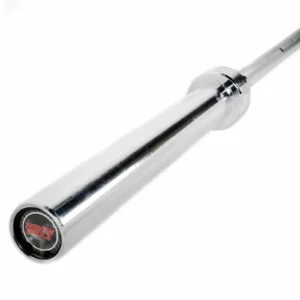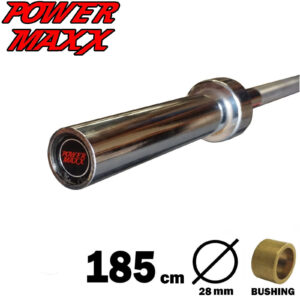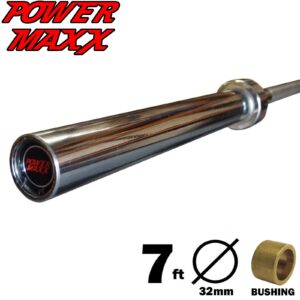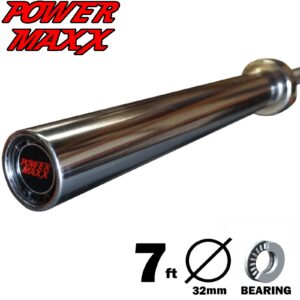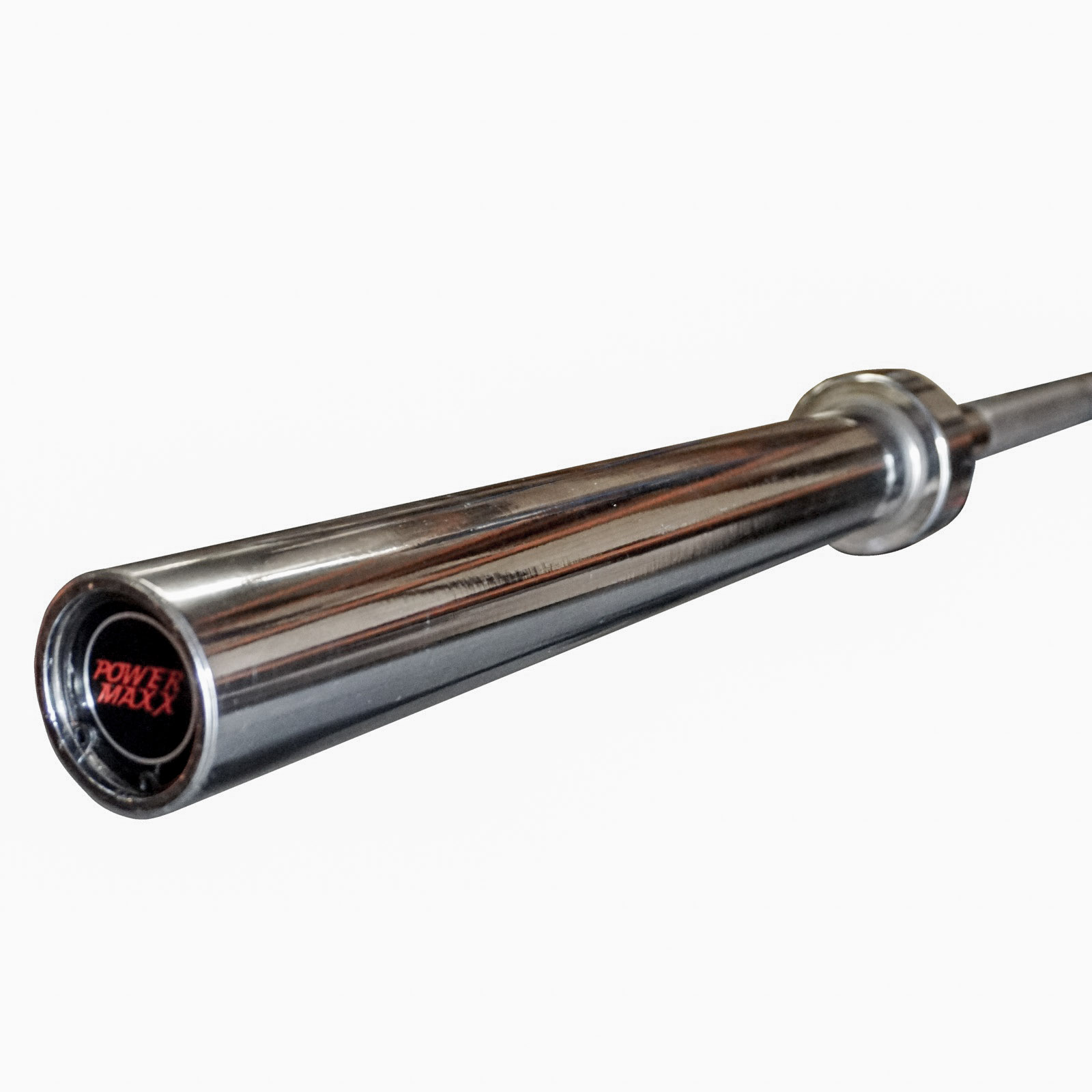
Olympic Barbells
Olympic barbells are a necessity for any strength training enthusiast and are the go to tool for working on those guns! Our barbells are built to take everything you can throw at them and perfect for all your free weight bar exercises. They come with a durable chrome coating, robust spring steel, a low price, and are available with copper bushings or bearings.
- Commercial, heavy duty construction
- Smooth rotation
- Great for power racks & squat racks
- Consistent knurling for a strong grip
- Smart, durable chrome finish
Showing all 4 results
Types of Bars
Copper Bush Bars
Don’t let the low-price fool you. These barbells are designed to take a beating. Over the years we have sold many of them to commercial gyms and studios.
Copper bushings require no maintenance as the copper is self-lubricating.
The sleeves might not spin as well as the bearings, but they will be more than enough for majority of entry level trainees.
Applications of the barbell – Powerlifting, General Strength.
Best plates to use – Olympic Weight Plates.
Thrust Bearing Barbells
As the name indicates the barbell sleeves come with built in bearings.
They offer smoother rotation, compared to Copper Bush Bars.
You need a lot of explosive power to complete a snatch or clean and jerk. Bearings reduces the torque produced by such lift. Allowing you to stray in control of the barbell the whole time.
I would recommend lubricating these barbells every once in a while, to ensure smooth rotation. As these bars do not posses the same features of self-lubrication as copper bushings.
Application of the barbell – Weightlifting, CrossFit, General Strength.
Best plates to use – Bumper Plates.
Accessory Bars
Most commonly used between bodybuilders and general strength enthusiasts. These barbells are great for isolating a specific muscle group. They are made out of the same materials as the 7ft barbells.
They come with the rotating sleeves, there might not be much explosive power in your bicep curls or triceps extensions, but it is always good to reduce the stress on your joints, regardless of the lift you are performing.
Another great feature of the accessory bars is that they accept the same Olympic plates as your 7 ft Olympic barbell.
Choosing the Right Barbell
Technique
Not everyone is strong enough to train with a 20 kg barbell. That’s why we have decided to add an aluminium technique bar to our barbell range.
Because of aluminium construction the weight of the barbell has been reduced to mere 7.5 kgs. Making this barbell perfect for any entry level weightlifter or inexperienced trainer.
Applications of the barbell – rehab, child training, women’s bar, weightlifting technique bar.
Please note this barbell has a load rating of 60 kgs. Once you have reached 60 kgs, you can switch to a normal Olympic Barbell.
Best plates to use – Technique Plates. Bumper Plates
Built to Last
Power Maxx entry level barbells are made out of spring steel, with sleek chrome finish and knurling.
7ft barbells come in two load ratings:
1000 lbs – offers slightly more whip, comes with a knurled, 30 mm thick shaft.
1500 lbs – stiffer bar with less whip. Knurled 32 mm shaft.
If you can’t decide which bar to get, I would recommend choosing a bar based on the thickness, not on the load rating of the barbell. There are only a few people in Australia who could come close to exceeding a 1000 lbs load rating.
We have supplied these barbells to many commercial gyms and studios across whole Australia. Just because these are budget barbells, does not mean they can’t take a beating. Feel free to swing by our showroom and give it a go!
No need to compromise
Space sometimes can be a decider between free weight and machine training. We came up with a solution – 185 cm barbell.
The length of the barbell has been reduced by shortening the sleeves of the barbell. The inner bar shaft has remained the same length making it suitable for all modern Squat Racks and Bench Presses.
If you think that you are going to run out of sleeve space. Have a look at our classic thin Powerlifting Discs.
Weight LiftingFrequently Asked Questions
How much does an Olympic Bar weigh?
As a standard most Olympic 7ft barbells weigh 20 kgs. When describing a barbell as “Olympic” it can refer to the barbells sleeve size which 50mm. It can also refer to its purpose – Olympic Weightlifting.
If we are talking about sleeve size, the weight of an Olympic barbell can vary. Barbells with Olympic sleeves come in varying lengths – 4ft, 5ft and 6ft barbells to name a few. These bars vary in weight from 8 kgs to 15 kgs. EZ curl bars, triceps bars and technique bars can all have Olympic sleeves.
Olympic barbells used in Olympic Weightlifting have standard weights. Women’s barbells are a tad lighter at 15 kgs, while men’s bars are 20 kgs.
How long is an Olympic Barbell?
A traditional Olympic Barbell which you would use for general strength training is 220 cm long. In saying that there are shorter barbells like the 185cm or 6ft Power Rack Barbell, which has reduced sleeve length but can still be used on a Power Cage or a Squat Rack.
To use an Olympic Barbell on a Cage you will need a clearance of at least 122 cm (measured between the sleeves). This will rule out all the 4ft and 5ft barbells with Olympic sleeves.
How thicc is an Olympic Bar?
There are multiple standards when it comes to Olympic bar thickness. There are multiple sports which use different shaft thicknesses.
1. Men’s Olympic Barbells are usually 29 mm in diameter.
2. Women’s Olympic Barbells are usually 25 mm in diameter.
This is because the ladies tend to have slightly smaller hands and might struggle to maximize their grip on a 29 mm thick barbell.
The main barbell thicknesses based on application are:
1. Powerlifting – 29 mm (for all three lifts in IPF approved competitions), some federations use 32-35 mm thick Squat bar, which helps to keep the barbell from “vibrating”, and 27 mm thick deadlift bar as it provides more “whip” aka bend making it easier to deadlift.
2. Weightlifting – Olympic Weightlifting barbells used in IWF competitions are 28 mm in diameter.
3. Hybrid – hybrid barbells are bars which can be used for both Olympic Weightlifting and Powerlifting. They are 28.5 mm in diameter.
4. Strongman/Grip Bars – the most common barbells used in Strongman competitions and grip/arm-wrestling training (also called fat bars) are approx. 50 mm in diameter.
5. General weight training bars – most of the barbells used for general strength training are approximately 30 mm in diameter. If you feel like you would like to challenge your grip, you can go for a thicker 32 mm barbell. These bars are generally cheaper than Powerlifting and Olympic Weightlifting barbells.
Thicker should be more expensive? Not in this case, the Powerlifting and Weightlifting barbells are designed for heavy use and dropping. To withstand this and also be thinner a better quality of steel is required.
What is the difference between an Olympic and Standard Barbell?
Olympic Barbells feature a universal 50 mm thick sleeve and are compatible with Olympic Weight plates. Most of the sleeves rotate which helps to stabilize the barbell, especially in Olympic Lifts.
Standard barbells are usually manufactured out of a single continuous piece of spring steel. They do not feature rotating sleeves and are only compatible with Standard Weight Plates.
In saying that, not all Standard weight plates will be compatible with standard barbells. There are different definitions for Standard Bars across the continents. For example, Imperial standard barbells are 1” (~25mm) in diameter. While Metric standard barbells can range from 27 mm to 30 mm.
Can you Bench Press with an Olympic Bar?
Olympic barbells are excellent for bench pressing! They are far stiffer compared to the standard barbells. Olympic bars usually feature significantly better knurling for grip. Quality knurling is very important as it will help to prevent your hands from slipping.
To bench press with an Olympic Barbell, you need to make sure that you are purchasing a compatible barbell that will work on your bench press or power cage. Most bench presses and cages require a 120-122 cm clearance between the sleeves. This is so that you could rack the barbell onto the J-Hooks which are on the uprights.
What are Olympic Bars made from?
Making a good Olympic Barbell is a tad more difficult than taking a solid steel tube, slapping some chrome paint on it, and adding the knurling.
Most Olympic Barbells are manufactured out of Spring Steel, Stainless Steel, or a combination of different Alloys such as chromium, molybdenum, silicon, and manganese. Higher end bars will be made from more exotic blends.
The sleeves rotated on bushes or bearings. The bars are finished in a variety of coatings, the most common being chrome. This would be the most durable. Bars can have different colour oxide or cerakote finishes. The options are growing as more people flock to weight training.
Why do Olympic bars Spin?
Olympic Bars spin to reduce the torque produced by an explosive lift. This allows the athlete to have a better control of the barbell. The quality of the spin is extremely important to Olympic Weightlifters and CrossFit enthusiasts.
You will generally get the smoothest sleeve spin from barbells which have bearings. But a high-quality bushed barbell will have a better spin (not necessarily faster but smoother) than a cheaper bearing barbell.
The two types of bearings are:
1. Ball Bearings – offer slightly better spin compared to bronze bushings, but they do get worse as you use them. Once you will drop the barbell from above your head you will put a tiny dent into the ball. Accumulate enough dents and your barbell will no longer spin as smoothy.
2. Needle Bearings – offer the smoothest spin out there. But they do come at increased cost. They are also more durable compared to ball bearing sleeves.
It is important to remember that you should not waste your money on a bearing bar for general strength training. If you don’t plan on performing a single explosive exercise you will not benefit from the smoother sleeve rotation.
The other reason why you should go for a barbell with bronze/copper bushings is maintenance. Bearing bars require lubrication to continue to spin smoothly. Some of them feature enclosed design, meaning that you will need to pull the barbell apart to put some oil onto the bearings.
Bronze/copper bushings are self-lubricating and require virtually no maintenance, outside of an odd clearing out of debris. On top of that barbells with copper bushings are used for general strength training where the spin of the sleeves is not important.

